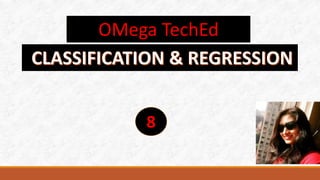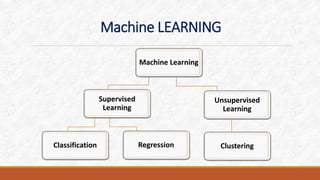Classification and Regression
- 2. BUSINESS INTELLIGENCE CLASSIFICATION & REGRESSION Mrs. Megha Sharma M.Sc. Computer Science. B.Ed.
- 3. Learning? “Learning in a computer system means acquiring information and storing it for future reference which can give out knowledge.” When we can make a machine learn like human or rather process and gather information and store for further processing we call it as “Machine Learning” Machine learning is a subset of Artificial intelligence which defines how machines learns without being programmed or with less programming.
- 4. Machine LEARNING Machine Learning Supervised Learning Classification Regression Unsupervised Learning Clustering
- 5. Supervised and Unsupervised Learning Supervised learning: Known inputs and outputs in the system and system acts on it with the given set of rules. Unsupervised learning: unknown inputs and outputs are not fixed. Green Red
- 6. CLASSIFICATION Classification is a process of categorizing a given set of data into classes, It can be performed on both structured or unstructured data. The process starts with predicting the class of given data points. The classes are often referred to as target, label or categories. Class A Class B
- 7. REGRESSION A technique for determining the statistical relationship between two or more variables where a change in a dependent variable is associated with, and depends on, a change in one or more independent variables. A regression problem is used when the output variable is a real or continuous value, such as “salary” or “weight”.
- 8. Comparison Classification Prediction are made by classifying data into different categories. The output variable in classification is categorical (or discrete) E.g.(i)Predicting gender of a person. (ii) Predicting result of a student (pass or fail) Regression The system attempt to predict value based on past data. The output variable in regression is numerical (or continuous). E.g.(i) Predicting age of a person. (ii) Predicting percentage of a student.
- 9. CLASSIFICATION MODELS. Heuristic models Separation models Regression models Probabilistic models
- 10. Characteristics of Classification models.
- 11. Thanks For Watching. Next Topic : Classification Algorithm.
- 12. About the Channel This channel helps you to prepare for BSc IT and BSc computer science subjects. In this channel we will learn Business Intelligence , A.I., Digital Electronics, Internet OF Things Python programming , Data-Structure etc. Which is useful for upcoming university exams. Gmail: omega.teched@gmail.com Social Media Handles: omega.teched megha_with OMega TechEd












